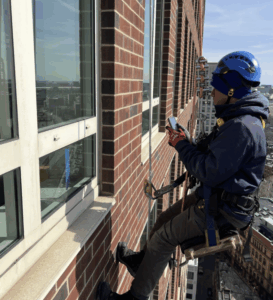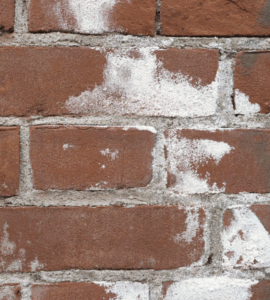Understanding Efflorescence: What That White Powder on Your Building Really Means
As the seasons change—especially moving from winter into spring—building surfaces begin to tell a story. One of the most common and often misunderstood signs that property owners notice is efflorescence: a white, powdery substance that appears on masonry, brick, or concrete. While it may seem like a minor cosmetic issue, efflorescence is often an early warning sign of moisture intrusion and should not be ignored.
Here’s what efflorescence actually is, why it forms, and what steps building owners and managers should take when they see it.


What is Efflorescence and Why Does It Matter?
Efflorescence occurs when water moves through a porous building material—like brick, block, or concrete—and dissolves naturally occurring salts within it. As that water reaches the surface and evaporates, the salts are left behind, creating a white, chalky residue. This process is especially common during spring, when increased humidity and moisture from thawing snow and rain are at their peak.
While efflorescence itself is not harmful, its presence indicates active moisture movement through your building envelope—which can lead to bigger issues over time.
What Causes Efflorescence?
Efflorescence is caused by three key elements:
- Water-soluble salts in the building material
- Moisture to dissolve the salts
- Pathways that allow moisture to move to the surface and evaporate
When all three are present, efflorescence can form on exterior walls, parking garage ceilings, foundation surfaces, and more.
It’s important to remember: the stain is the symptom, not the root cause. Removing the residue without stopping moisture infiltration will only lead to its return.
Related Conditions to Be Aware Of
Sometimes what appears to be efflorescence may actually be a related phenomenon. Understanding the differences can help determine the right course of action:
- Lime Run: A similar white stain that hardens into calcium carbonate. Unlike efflorescence, it does not dissolve in water and often requires aggressive cleaning methods.
- New Construction Bloom: Typically seen in new buildings during winter or early spring. It’s the result of uncured materials reacting to rapid interior heating and may not indicate a long-term issue. However, it’s still worth monitoring.
How to Identify and Address Efflorescence
Efflorescence is relatively easy to spot. Look for:
- White or gray powder on masonry or concrete
- Discoloration on brick walls or garage ceilings
- Powder that disappears temporarily when sprayed with water
While the residue can be removed with water or light pressure washing, this is only a temporary fix. If the moisture issue isn’t corrected, the salts will reappear—sometimes within days.
Long-Term Solutions Include:
- Inspecting for leaks, cracks, or faulty waterproofing
- Improving drainage or downspout systems
- Resealing exterior walls or applying breathable coatings
- Consulting a building envelope specialist to assess hidden issues
Final Takeaway
Efflorescence is more than just a surface stain—it’s a sign that water is moving through your building materials. And where there’s water, there’s the potential for damage. Cleaning it may solve the visual problem for now, but the real value lies in identifying and eliminating the source of moisture.
If you spot efflorescence—or something that looks like it—don’t ignore it. Whether it’s efflorescence, lime run, or another moisture-related condition, it’s worth taking a closer look to protect your building’s long-term performance and value.